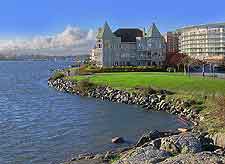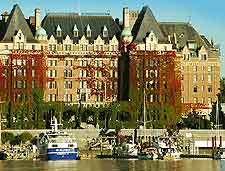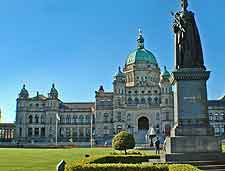Victoria History Facts and Timeline
(Victoria, British Columbia, Canada)

Even though the city of Victoria is not an overly 'old' settlement, there is evidence in history to show that the Songhees Indigenous North American people resided in the area long before the arrival of European explorers.
As a matter of fact, when Victoria was first constructed as a trading fort along the southern reaches of Vancouver's coastline, a traditional Songhees village was already established at Finlayson Point. Since the arrival of European settlers, the population of Songhees has dwindled dramatically to less than 200.

Exploring the Northwest
European explorers, including James Cook and Juan Perez, sailed along this northwest coastline throughout the 1700s, but it was the Spanish who first discovered the Victorian area of the island in 1790. The first area to be explored was the western region of modern-day Victoria, known as Esquimalt.
The city of Victoria was first established as a Hudson's Bay Company trading port in 1843 by James Douglas. However, a site was chosen on the eastern side of Gorge Inlet, rather than Esquimalt. This lead to the development of Fort Albert, which later became Fort Victoria, taking its new name after the then Queen of England.
Royal Canadian Navy
In 1865, the area just west of central Victoria, known as Esquimalt, became the North Pacific home of the Royal Navy. The city's role as a naval base was an important influence in its development as British Columbia's most significant settlement in the late 1800s. The Royal Canadian Navy still resides at Esquimalt.
The settlement of Victoria grew in stature in the second half of the 19th century, thanks to the gold rush and the booming opium trade. Victoria became the capital of the United Colonies in 1866 and by the end of the 19th century, significant developments in the city had been made, including the arrival of Craigdarroch Castle, Butchart Gardens and the Canadian Pacific Railway terminus.
Prior to European settlement, the Songhees resided in the area. After the arrival of European explorers, the population of these indigenous peoples declined significantly. Today, tourists can visit Beacon Hill Park, which was originally a burial site for the native tribes of Southern Vancouver. The fourth-tallest totem pole in the world can be found at the park.

Victoria - Provincial Capital
Instilled as the capital of British Columbia in 1871, Victoria saw the construction of its parliament buildings within the Inner Harbor district. A real estate boom hit the city until WWI, although steady development and expansion of Victoria has occurred since. The legacy, however, is a number of stately Edwardian buildings that give the city its character. These buildings can today be explored by tourists, with tours usually lasting for about 30 minutes. At night, the buildings are lit up like large Christmas trees.
In the late 1800s,
Vancouver became the center of British Columbia's commerce. It was following this prosperous time that Victoria developed an awesome display of unsurpassed architecture, infrastructure and tourist sights. Some of these amazing draws can still be explored today, including the impressive Butchart Gardens, the Empress Hotel and stunning Craigdarroch Castle.
Victoria lost its commercial status to Vancouver when a bigger, better port was built further inland, although it does remain the capital of British Columbia and retains a gentile character, with gardens, history and a sizeable student population. Local tourists from Vancouver tend to keep the city busy in the summer.
 Even though the city of Victoria is not an overly 'old' settlement, there is evidence in history to show that the Songhees Indigenous North American people resided in the area long before the arrival of European explorers.
Even though the city of Victoria is not an overly 'old' settlement, there is evidence in history to show that the Songhees Indigenous North American people resided in the area long before the arrival of European explorers.
